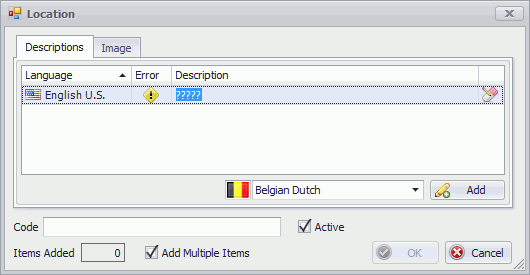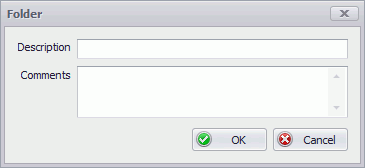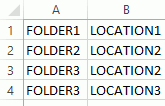A location is the position of the part in relation to the entire product. For example, in a motor vehicle a repair technician needs to distinguish between a left or right side fender. The part is the fender, while the location would be left or right.
The part and the location together are called a component.
Creating a New Location
Select the Products tab.
Click Locations.
A list of the existing locations and location folders is displayed.
Click the add icon (![]() ) below the right-hand pane.
) below the right-hand pane.
The following popup appears:

Enter a description and code for the location.
If required, add an image in the Image tab.
For a description of how to add an image see here.
Click OK.
The location is added to the list.
-
Keep in mind that Inspect considers a unique part to be a part + location. If you wish to track costs by exact location, that is, left side fender vs. right side fender, there must be a unique part + location for each fender.
Creating Location Folders
The Location Folders are used to make a large list of locations more manageable, since folders reduce the amount of scrolling you need to do.
Select the Products tab.
Click Locations.
A list of the existing locations and location folders is displayed.
Click the add icon (![]() ) below the left-hand pane.
) below the left-hand pane.
The following popup appears:

Enter a description.
Enter comments if required.
Click OK.
The folder is added to the list.
Click and drag locations from the right-hand pane onto the folders in the left-hand pane to associate them.
Importing Locations and Folders
Locations and location folders can be specified in an Excel spreadsheet and then imported directly to the Inspect database.
There are three different import options. Each one requires a separate spreadsheet and different information as shown below:
|
Data being imported |
Information required in first two columns |
|
Locations |
Location description, Location code |
|
Location Folders |
Location folder description, Location folder code |
|
Location Folders / Parts |
Location folder code, Location code |
Create the spreadsheet
Create a new spreadsheet.
Fill in the required information as listed in the table above.
There is no header row.
If you are importing location folders and locations then you can include as many combinations as you like, as shown below.

Save the file with a descriptive name.
Import the spreadsheet
Select the Products tab.
Click Locations.
A list of the existing location folders and lcoations is displayed.
Import as follows:
Locations - Click the Import button ( ) below the right-hand pane.
) below the right-hand pane.
Location Folders - Click the Import button ( ) below the left-hand pane, select Folders and click OK.
) below the left-hand pane, select Folders and click OK.
Location Folders / Locations - Click the Import button ( ) below the left-hand pane, select Location Folders/Locations and click OK.
) below the left-hand pane, select Location Folders/Locations and click OK.
The Import Wizard window opens.
Click Next.
Either enter a file path or click the folder icon to locate and open the spreadsheet.
The spreadsheet information is checked to see if it is valid. Invalid data will be highlighted in red.
If required, select the Errors tab to see which data is incorrect.
Errors must be fixed in the original spreadsheet. You can then click the Refresh button ( ) in the wizard to re-import the spreadsheet.
) in the wizard to re-import the spreadsheet.
Click Next.
If required, disable any items you don't want to import.
Click Next.
Click Finish.
The data is imported to the Inspect database.